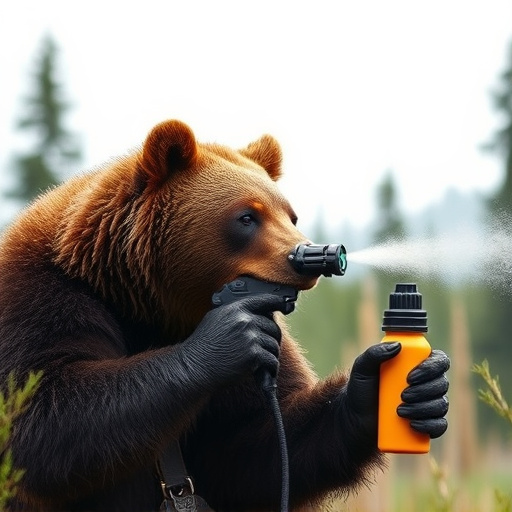Bear spray residue impacts wildlife beyond deterrence, affecting sensory systems and behaviors. While effective for human safety, its active ingredients can linger in air and on surfaces, reaching beyond visible range. This residual effect disrupts ecosystems, especially in sensitive areas, requiring responsible usage and research into less environmentally harmful alternatives to protect Alaska's diverse wildlife.
“Alaska’s rugged terrain and abundant wildlife make understanding bear repellent effectiveness crucial for outdoor enthusiasts. This article delves into the mysteries of bear spray residue, its impact on wildlife, and the often-misunderstood maximum range. We explore how these repellents, designed to protect against aggressive bears, leave behind more than just a scent. By examining ‘Bear Spray Residue’ and its ‘Wildlife Impact’, we separate fact from fiction regarding maximum range claims. Additionally, we question their environmental effects, offering insights for responsible outdoor adventure in bear country.”
- Bear Spray Residue: What Stays Behind?
- Wildlife Impact: More Than Meets the Eye
- Maximum Range: Fact vs. Fiction
- Effective Protection or Environmental Concern?
Bear Spray Residue: What Stays Behind?
Bear spray, a popular and effective deterrent, leaves behind more than just a pungent scent. When used correctly, it creates a protective barrier that can repel bears for several minutes. However, what many users don’t realize is that bear spray residue has its own impact on wildlife.
While the active ingredients in bear spray are designed to temporarily disable or deter bears, these compounds can remain on surfaces and potentially affect other animals. The residue may harm non-target species by interfering with their sensory systems, much like it does with bears. Understanding the longevity and effects of bear spray residue is crucial for both users’ safety and the preservation of local ecosystems, highlighting the need for responsible usage and proper disposal techniques.
Wildlife Impact: More Than Meets the Eye
When considering bear repellent maximum ranges, it’s crucial to look beyond just the visible distance. The impact of bear spray residue extends far beyond what meets the eye. Bears have a keen sense of smell, and even after the initial burst of spray dissipates, residual chemicals can linger in the air and on surfaces for extended periods. This means that while the visible range may be 30 to 60 feet, depending on the product, the actual effective zone could be significantly larger, impacting not just direct targets but also nearby wildlife.
The presence of bear spray residue can alter behaviors and habitats. It may deter bears from certain areas, changing their feeding patterns and forcing them into different territories. This ripple effect on the ecosystem is often overlooked but plays a significant role in understanding the true wildlife impact of using bear spray as a repellent. In areas where bears are already sensitive or declining, these residual effects could have profound consequences for the local fauna and flora.
Maximum Range: Fact vs. Fiction
Many people wonder about the maximum range of bear spray, especially when considering its effectiveness in protecting against wildlife impact. It’s important to understand that the concept of a “maximum range” is often misunderstood. Bear spray isn’t like a bullet that travels a specific distance; instead, it’s an aerosol that creates a cloud of protective residue. The effective range isn’t about how far the spray can reach, but rather how close you are when you apply it.
When used correctly, bear spray can create a protective barrier within a few feet, giving you valuable time to retreat or defend yourself. However, the residual effect varies based on factors like wind speed and direction, terrain, and the specific product’s concentration. Bear spray residue typically lingers in the air for a short period, offering protection beyond the immediate cloud but not extending indefinitely into the distance. Remember that proper application is key; spraying too late or incorrectly may reduce its effectiveness against wildlife impact.
Effective Protection or Environmental Concern?
When it comes to bear repellent, one of the most commonly used tools in Alaska is bear spray. Its effectiveness in protecting individuals from aggressive bears has been well-documented. The maximum range of bear spray is a topic of interest, as users want to ensure they are adequately protected while hiking or camping. However, the environmental impact of bear spray residue is a growing concern among conservationists and wildlife experts.
While bear spray can provide effective protection against attacks, its long-term effects on wildlife and ecosystems should not be overlooked. The active ingredients in bear spray can linger in the environment, potentially impacting non-target species and altering natural behaviors. As Alaska’s diverse wildlife depends on a delicate balance, it is crucial to consider the broader ecological implications of using such repellents. This debate highlights the need for responsible usage and further research into less environmentally disruptive alternatives.
Understanding the maximum range of bear repellent, such as guard Alaska bear spray, involves considering both its effectiveness against wildlife impact and the lingering residue of bear spray. While manufacturers often exaggerate ranges, it’s crucial to recognize that proper usage and knowledge of bear spray residue are key to ensuring safety in bear country. By understanding these factors, outdoor enthusiasts can make informed decisions, balancing effective protection with environmental considerations related to bear spray residue.
